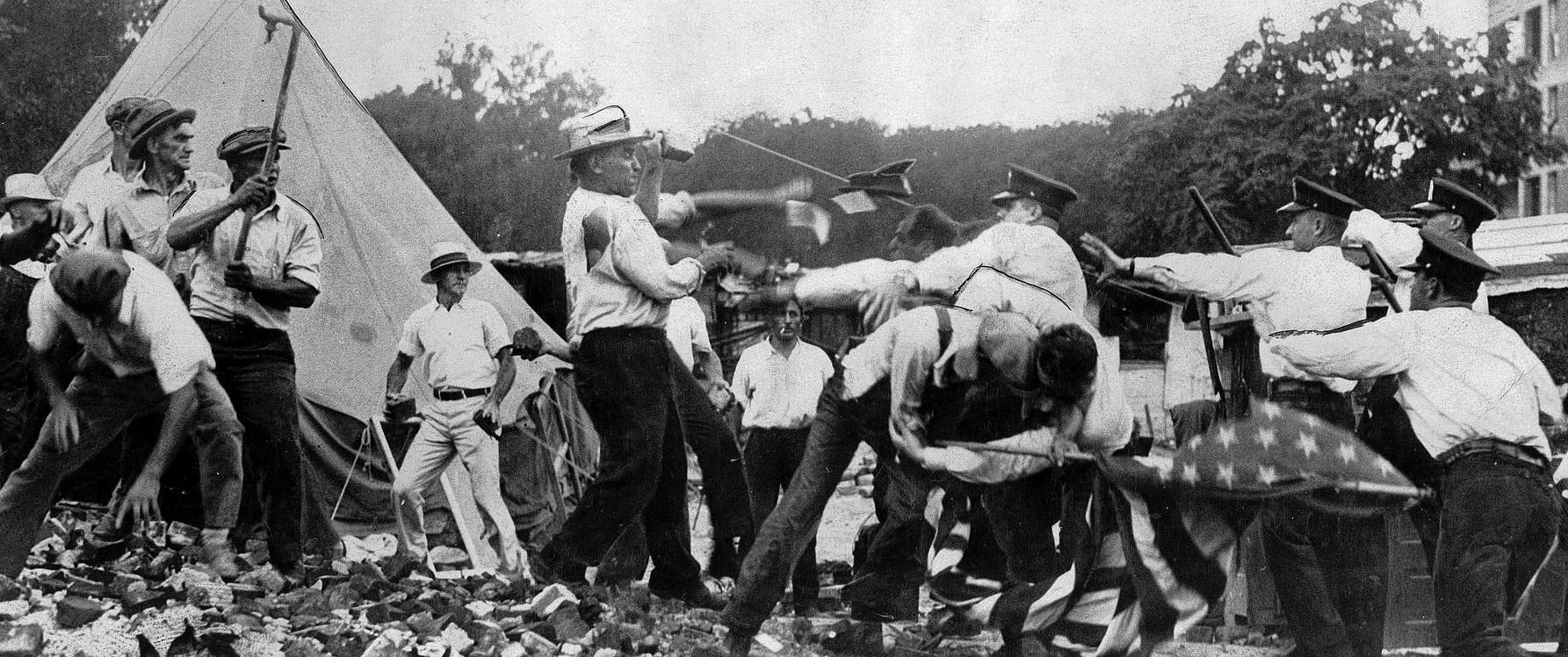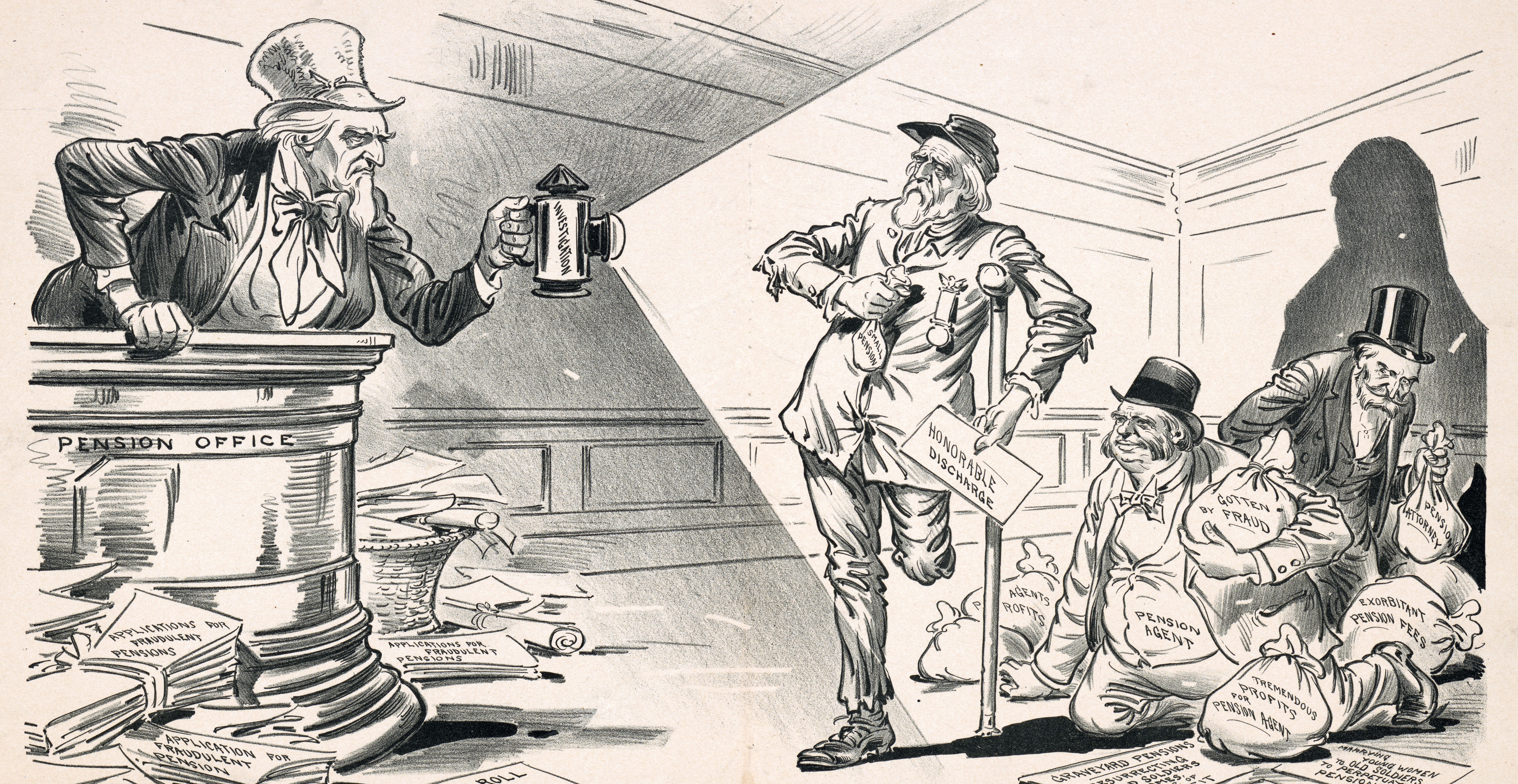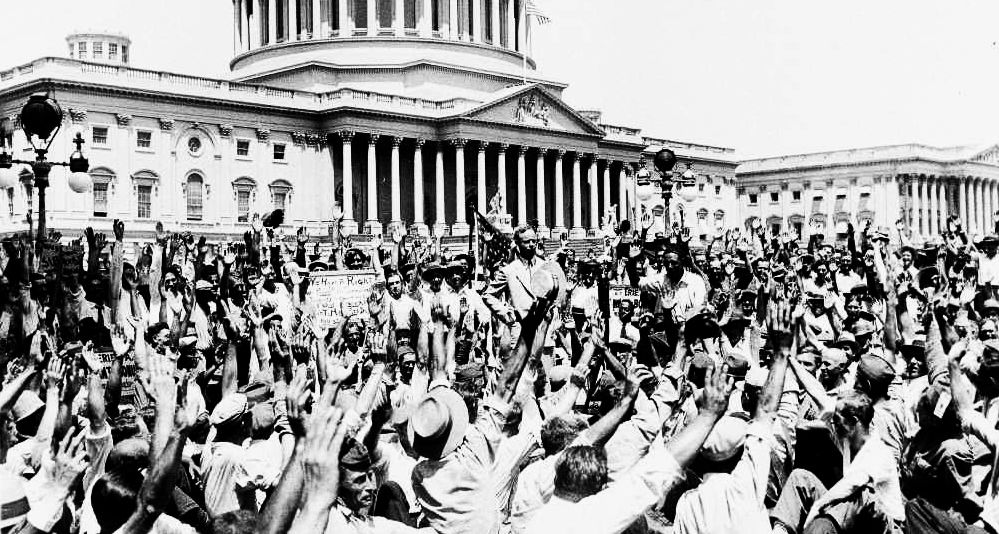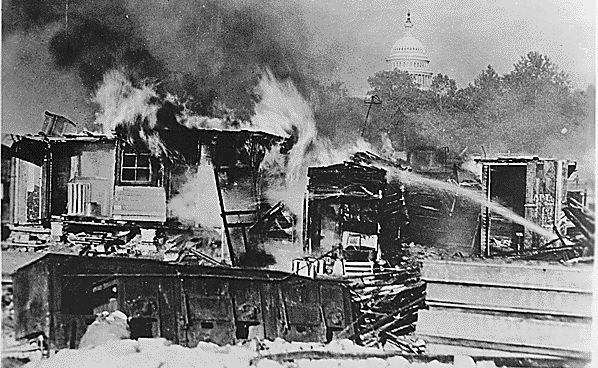In the largest protest of the Depression, World War I veterans converged on Washington, DC seeking justice. They were met with tanks, bayonets, and tear gas.
-
July/August 2020
Volume65Issue4
Editor’s Note: We asked historian Paul Dickson to give us some perspective on the recent demonstrations in the Nation’s Capital. He pointed to the effort by thousands of veterans to get help during the Depression — protests that were met with violence, but eventually led to profound changes. Mr. Dickson coauthored The Bonus Army: An American Epic with Thomas B. Allen, and is the author of over 60 other books.

President Donald Trump’s threat to bring 10,000 Federal troops to the Capital to enforce the law after recent demonstrations is hardly the first time that the U.S. Army has been called upon to move against civilians. In 1932, an estimated 17,000 veterans and their families headed to Washington from across the country to protest and were set upon by cavalry, infantry, tanks and machine guns.
The marchers demanded payment of the “bonus” promised in 1924 to soldiers who had served in the Great War, but deferred until 1945 because of wrangling over the federal budget. Now, deep in the Depression, the vets had dubbed the delayed payment the Tombstone Bonus, for the only way to get the cash before 1945 was to die, in which case the payment would be made to the next of kin as a death benefit.
Victorious war veterans have vexed politicians since the days of Caesar’s legions. Returning warriors were both a potential power bloc and a threat — men who marched off to serve the state in war and then straggled back in peacetime, brewing discontent and looking for rewards. The Romans established the Aerarium Militare, the first veterans’ bureau, to deal with the ex-soldiers who demanded pensions and balm for their wounds.
In Elizabethan times, discharged soldiers and sailors became beggars and highwaymen. London ironically invoked martial law to cope with the warrior mobs. A royal proclamation threatened summary executions for “mariners, soldiers, and masterless men” who did not leave London immediately.
In colonial America’s earliest days, recognition was given to wounded soldiers. In a proclamation of 1636, the leaders of the Plymouth Colony of Massachusetts declared, “If any person shall be sent forth as a soldier and shall return maimed he shall be maintained competently by the Colony during his life.” Early in the Revolutionary War, the Continental Congress provided pensions for both disabled veterans and the dependents of soldiers killed in battle. The last surviving dependent of the Revolutionary War continued to receive benefits until 1911.
But what of the men who return whole? Even as noble a cause as the American Revolution ended with a disgruntled army, menacing the politicians.

When the governor of Pennsylvania, who was in attendance, was asked to call for his militia, he said he would not be able to protect Congress because he could not count on his militia to follow his orders. Fearing a coup d’état, Congress “quit the building,” pushed through the jeering armed mob, and headed to Princeton, New Jersey.
For weeks the soldiers held their ground. They grew into a mutinous mob of four hundred, making daily demands on the government and terrorizing the citizens of Philadelphia. Finally, after weeks of the renegade soldiers’ daily demonstrations and threats, George Washington sent a force of fifteen hundred Continental soldiers to compel the men to return to their homes. Two of the leaders of the mutiny were sentenced to be shot, led out to be executed, and faced a line of soldiers with loaded guns. At the last minute they were pardoned by Congress. Other leaders were whipped before being released.
The Revolutionary War mutinies were not about power or ideology but simply about being paid for services rendered. They would establish what became a social contract between the nation and those who fight its battles: when a war ends, members of the military must be paid in full for their service. Although most Revolutionary War veterans were not paid for years, most eventually got back pay and pensions.
The mutiny had another consequence. During the Revolutionary War, Congress had retreated three times from Philadelphia — first to Baltimore, then to Lancaster, and then to York — to avoid capture by the British. But Congress had always returned to Philadelphia. After the 1783 mutiny and the humiliating departure, the members vowed never to return. They stayed at Princeton until the end of the year, then moved to Annapolis, followed by Trenton, and finally to New York.
When the Constitutional Convention met in 1787, memories of 1783 were still so fresh in the delegates’ minds that they wrote a provision into the Constitution, providing for a new kind of capital — a federal enclave, which would become Washington, D.C., by the turn of the century.
Just as mutinous veterans of the Revolution had had enough power to move the capital, veterans of the Great War, by marching on that capital in 1932, were able to move the nation to a new social contract that is still valid today.
From the end of the Revolution to the return of the first American troops from Europe in 1918, the issue of compensation for veterans had frequently confronted Congress. When the Civil War began in 1861, there were about eighty thousand pensioners whose service dated back as far as the War of 1812. By the end of the Civil War in 1865, nearly 2 million veterans were collecting pensions.
Veterans, who made up about 5 percent of the population, became a powerful voting bloc. They showed that power by forming America’s first veterans’ organization, the Grand Army of the Republic. Five presidents were GAR members, as were most northern governors. Membership in the GAR was practically a requirement for election to any public office in the North. Thanks primarily to the GAR, at the height of its power in the 1870s more than one-fifth of the national budget went toward veteran pensions. America evaded the problem of disgruntled veterans by paying relatively generous pensions — and by expanding westward, creating jobs for homecoming veterans of North and South.
When World War I began in 1914, there were still more than four hundred thousand Civil War veterans collecting pensions, along with tens of thousands of men who had fought in the Spanish-American War. Although the original intention of pension legislation was to provide for the wounded and their survivors, by 1914 the overwhelming majority of pensioned veterans had left the Army, Marines, or Navy intact in mind and body.
But as the power of the GAR waned, so did congressional sympathy toward able-bodied veterans. The war in Europe inspired interest in another kind of benefit: insurance. In 1914 Congress passed the War Risk Insurance Act, which provided government insurance to American ships running the German submarine gauntlet to carry war supplies to Europe. American politicians and corporate executives believed that this would be the extent of America’s participation in a strictly European war.
In 1917, however, America was drawn into the war, and President Woodrow Wilson endorsed war-risk life insurance for American soldiers and sailors who voluntarily signed up and paid the premiums through deductions from their pay. Congress authorized the plan with a unanimous vote. Wilson and the Congress wrongly believed that there would be no demand for postwar compensation to those who were not injured during their service.

The Doughboys who came home carried a palpable sense that they had been left behind and deserved some kind of financial compensation for their service beyond the mere dollar-a-day base pay they had received. Their demands reached Congress through successors to the GAR: the American Legion and Veterans of Foreign Wars. Year after year, Congress debated, always holding out the promise of reward.
Finally, in 1924, six years after the Armistice that ended the Great War, Congress enacted a law that granted Great War veterans “adjusted universal compensation,” which became known as the bonus. The legislation was passed over the veto of President Calvin Coolidge, who declared, “We owe no bonus to able-bodied veterans of the World War.”
The law would give any veteran who served during the war compensation at the rate of a dollar a day for domestic service, and an extra twenty-five cents for each day spent overseas. Those entitled to fifty dollars or less were paid immediately; the rest were to receive certificates that could not be redeemed until 1945.
Although there were periodic calls for speeding up payments, nothing happened until May 1929, five months before the stock market’s Black Tuesday, when the Dow Jones Industrial Average plunged by 12.9 percent, beginning the great stock market crash and foreshadowing the Great Depression. Freshman representative Wright Patman, a Texas Democrat and a veteran, cosponsored a bill calling for immediate cash payment of the bonus, which Patman called “an honest debt.” The bill never made it out of committee.
Under Patman’s leadership, further attempts to get the bonus paid failed; the nation slipped deeper and deeper into economic and spiritual despair as many of the millions of the homeless settled in communities of makeshift shacks called “Hoovervilles” after the president they blamed for their plight.
The bonus impasse went on until March 15, 1932, when a jobless ex-sergeant, Walter W. Waters, stood up at a veterans’ meeting in Portland, Oregon. He proposed that every man who was present hop a freight and head for Washington to get the money that was rightfully theirs.
Waters got no takers that night, but pressed on with his idea for a march, bending the ear of every veteran he could find.
Finally, on May 11, when a new version of the Patman bill was shelved in the House, some 250 veterans, with only thirty dollars among them, rallied behind a banner reading “Portland Bonus March—On to Washington” and trekked to Portland’s Union Pacific freight yards. A few hours later, a freight train emptied of livestock but still reeking of cow manure stopped to board some three hundred men.
They called themselves the Bonus Expeditionary Force (BEF), a play on American Expeditionary Force, the collective name for the troops sent to France. They became known as the Bonus Army.
Some people saw them simply as men of the Great Depression, homeless, hopeless, and looking for cash. But for many who had fought in the war, these were their comrades, the Yanks of France, the Doughboys who had been “Over There.” These were men who had lived in the trenches and, when the order came, had gone over the top.
Walter Waters, who had started the movement, became a symbol for the individual who, in seeking redress for a grievance, changes the course of history. Among those he inspired was a thin, battered man named Joe Angelo of Camden, New Jersey. As he made his way to Washington, Angelo carried his Distinguished Service Cross, won for valor in the trenches of France. Another was Sewilla LaMar, a black woman who had lost both her first husband and her brother in the war; she walked and rode boxcars from Los Angeles to Washington to fight for the bonus.
The events in Washington in the summer of 1932 involved men who would become three of the most famous American generals of the twentieth century, acting in roles largely forgotten today. To Douglas A. MacArthur, George S. Patton, and Dwight D. Eisenhower would fall the duty of obeying commander in chief Herbert Hoover, who ordered the expulsion of the Bonus Army from Washington.
At the foot of Capitol Hill were tanks, bayonets, and tear gas. Two veterans were killed by a policeman who was murdered less than a month later. Soldiers put the sprawling main Bonus Army camp to the torch. The veterans and their families began a forced exodus.
Most accounts of the Bonus Army end with newsreel coverage of veterans marching off into obscurity. But this is not how it played out in real life. What lay ahead for many of the veterans were futile returns to New Deal Washington, dollar-a-day labor in remote federal work camps, and a hurricane unlike any ever recorded in the United States. Wind gusts estimated at two hundred miles an hour slammed into work camps in Florida’s upper Keys, turning granules of sand into tiny missiles that blasted flesh from human faces. The storm brought death to at least 259 veterans. The final indignity was mass cremation.
How could the Bonus Army be forgotten in the pages of textbooks and twentieth-century histories? Perhaps because it was seen narrowly as an incident leading to the defeat of Herbert Hoover, rather than as a major historic event and catalyst for change in itself.

Perhaps it is because the Bonus Army was integrated. While the American Expeditionary Force in Europe had been segregated — America’s 404,000 black soldiers, barred from all-white units, had fought under a French flag — veterans of both races marched together in the demonstrations and lived together in Washington in integrated camps. Roy Wilkins, a young writer for the NAACP magazine, the Crisis, saw the Bonus Army as a model for an integrated America.
Another reason for marginalizing the Bonus Army is that many people dismissed the whole movement as a function of Communist organizers. This erroneous belief was supported by covert work by a federal intelligence apparatus that kept the marchers under constant surveillance for dangerous radicals. Informants, sometimes using coded radio messages, passed along the names of suspected subversives to military leaders who feared armed rebellion. Undercover operatives ferreted out “plots” from both the left and the right.
The key hunter of subversives was General MacArthur’s “most trusted subordinate,” Brigadier General George Van Horn Moseley, who, from his post in the U.S. Army’s Military Intelligence Division, saw in the integration of black and white veterans living proof that “Negro and Jewish” Communists were planning a revolution. Working with Moseley were the Secret Service, “Red Squads” in big-city police departments from Portland, Oregon, to New York City, and the Justice Department’s Bureau of Investigation under a young J. Edgar Hoover. Evidence of this widespread domestic spying remained secret for decades; many surveillance files were not declassified until 2000.
There were, in fact, radicals and Communists among the bonus seekers, but they were an ineffective minority disdained and dismissed by the main body of the BEF.
The march of the Bonus Army was not a mere Depression-era incident — it was a great American epic lost in the margins of history. Those who recall it are prone to slant events to advance their own political beliefs. Just as there are those who feel that it was a tale of government turning on its people, there are those who believe the veterans were hapless victims of Communist manipulation. There are even some that deny it ever happened, perceiving it as a fairy tale concocted to discredit Hoover and MacArthur.
The need for a social contract between nation and soldiers, first perceived by the angry veterans of the Revolutionary War and then peacefully sought by the Bonus Army, became a reality with the GI Bill in 1944. And the contract endures, for veterans of war and peace, into the twenty-first century.
That great change, that guarantee of a just reward and the resulting creation of a vast productive and creative middle class, is the magnificent legacy of the Bonus Army.

